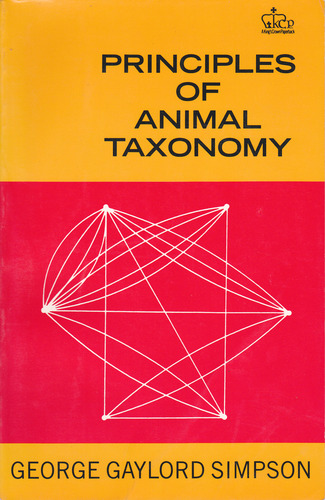Principles of animal taxonomy epub
Par weaver mitchell le dimanche, juillet 24 2016, 03:41 - Lien permanent
Principles of animal taxonomy by George Gaylord Simpson


Principles of animal taxonomy George Gaylord Simpson ebook
ISBN: 023109650X, 9780231096508
Publisher: Columbia University Press
Page: 131
Format: djvu
This course begins with an overview of key concepts in zoology as students examine the characteristics of the animal cell and discuss heredity and issues of evolution, including natural selection. While he continued throughout his lifetime to revise and expand this great work, so his successors have continued to revise the principles of taxonomy, now according to genetic principles, informed by the analysis of DNA. They then turn to taxonomy, as they study increasingly complex types of animals. History Among the dynamics in play here, we can see the general and specific principle at work. Okay, so I was talking about FPJ 140 or ZOO 140 (Animal Taxonomy). The system that we still use today for giving scientific names to plants and animals has many founders, from the Greek philosopher Aristotle to the Swedish physician and botanist Carolus Linnaeus. Tylodes as a cnidarian, or jellyfishlike creature, was wrong, the researchers report today (Jan. Most think that taxonomy is boring and difficult. [that] are designed to enable zoologists to arrive at names for taxa that are correct under particular taxonomic circumstances. Yeah, it is difficult but it is not boring at all. The first section "Conservation Medicine" introduces fundamental principles in conservation biology, ecology and environmental health assessment as a foundation for understanding wild animals and their diseases in a wider framework. Cuvier's The Animal Kingdom, Arranged According to its Organization, Serving as a Foundation for the Natural History of Animals, was an attempt to classify the animal kingdom on the basis of comparative anatomy, of which Cuvier's entire classification schema was Using these principles, Cuvier established a taxonomic approach based on comparative anatomy that established correlations between the inner systems that maintained life within an organism. The classic example is Linnaeus' animal kingdom taxonomy. Many fast food joints depend on this principle. By: Stephanie Pappas, LiveScience Senior Writer Published: 01/17/2013 10:07 AM EST on LiveScience An ancient sea animal that looked like a flower had its anus right next to its mouth, a new fossil study finds. While doing a presentation on the Principles of Taxonomy, I was asked the question of “How do you know when to choose a hierarchical taxonomy or a faceted taxonomy? From microscopic investigation to the basics of veterinary medicine, Zoology covers principles of comparative animal anatomy, physiology, and genetics. The research reveals That gut proved that the previous classification of C.